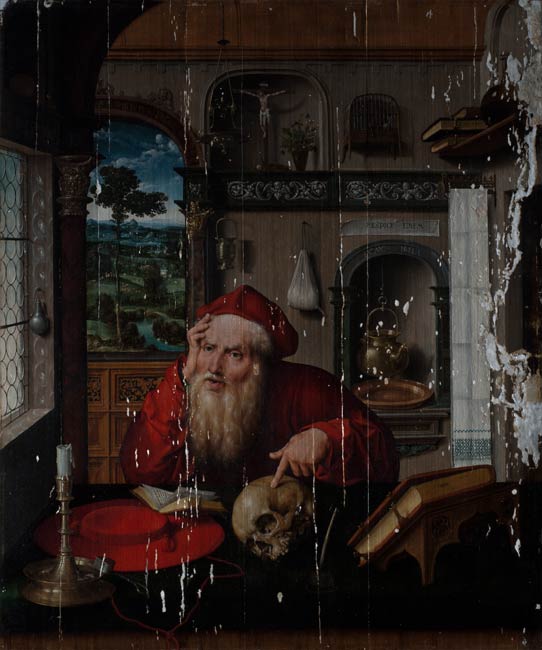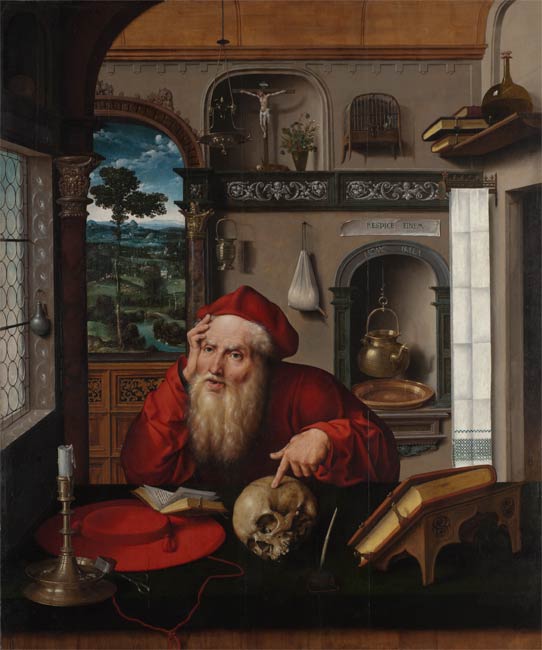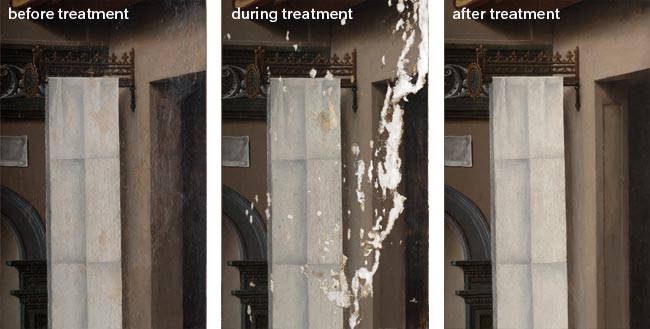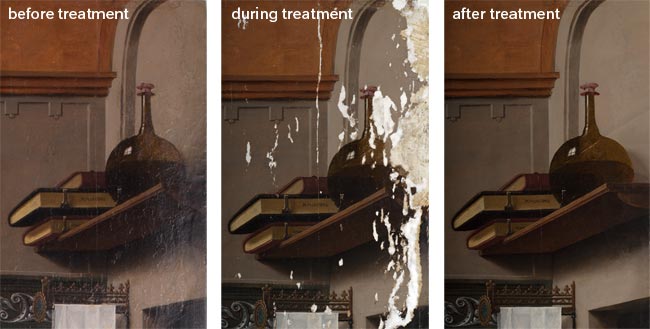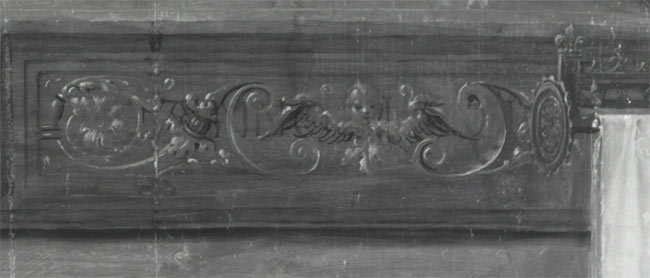If you stumbled upon paintings conservator Dina Anchin discussing the conservation of Joos van Cleve’s Saint Jerome in His Study, you might think she was describing a recent camping trip. Tenting and woodworm damage were among her largest concerns. While the painting was not exposed to the great wild, it lived in less than ideal conditions over the last 500 years.
Unstable environmental conditions made the wood panel expand and contract, causing the paint on either side of the resulting cracks to lift. This is referred to as “tenting” in the conservation field. Anchin treated the tenting by introducing glue into the empty spaces beneath the lifting paint and using a combination of gentle heat and pressure to flatten the paint back onto its support.
Woodworms caused additional damage by tunneling through the panel, resulting in depressions and disruptions in the paint surface. The smooth surface of a wood panel allows an artist to execute intricate details and adds to its aesthetic appeal. Fills done in previous restorations were uneven and visually distracting (a fill or filling is a material such as gesso or spackle used to replace lost paint). Anchin sanded and reworked the uneven old fills before in-painting the missing elements.
Large areas of fill on the right side of the painting presented Anchin with quite a challenge. Previous restorers in-painted the doorway, the shelf, and the upper wall with broad strokes of paint that discolored over time. Looking closer, Anchin and Landon and Lavinia Clay Curator Stephan Wolohojian noticed details in the few remaining pieces of original paint that alerted them to the fact that something more was going on. Luckily, for guidance there is a similar composition of St. Jerome in His Study found in the collections of the Frances Lehman Loeb Art Center at Vassar College in Poughkeepsie, NY.
Studying Vassar’s painting yielded rich findings: conservators realized that the darkened line at the bottom of the doorframe was actually part of a missing molding detail; the shelf bracket was smaller and ended in a neat rounded edge; and a sharp white line through the vase on the shelf was not a mysterious reflection, but rather a view of the edge of the wall molding seen through the clear vase. With this new point of reference, Anchin was able to restore these elements omitted by previous conservators. She spent more than 160 hours (over a nine-month period) immersed in restoring these details. It’s no surprise, then, that Anchin developed a great admiration for this work.
An infrared (IR) scan of the painting led to even more discoveries. A detailed underdrawing revealed several elements that didn’t appear in the final painting: the bird cage, for instance, was originally suspended from a wire on the ceiling and the tassel on St. Jerome’s red hat draped straight down instead of curving to the side. If you look closely when St. Jerome in His Study is hanging in the new galleries of the Harvard Art Museums, you will see these alterations yourself in areas where the underdrawing peeks through.
But the most fascinating revelation of all was discovered behind the decorative frieze below the niche on the back wall. Since it came into our possession, this work was given the soft date of 1520–24. But behind the frieze are the words “Anno 1521” (Year 1521), which finally gave us the hard date of its creation and solidified the work as one of the earliest iterations of Van Cleve’s Saint Jerome.
With all of the care taken to conserve this painting, conservators and curator Stephan Wolohojian determined that the existing 20th-century frame was inadequate. The style was inappropriate and it cropped out critical elements of the composition. Frame conservator Allison Jackson worked with Brett Stevens, a framemaker in Groton, MA, to construct a cassetta-style frame based on northern European period frames. The new white oak frame mimics 16th-century construction methods, including lap joinery with applied moldings and dowels at the miters (the angled edge of the frame). Jackson will artificially age and stain the frame.
Thanks to the research, collaboration, and keen observation by a team of conservators and curators, Saint Jerome will soon be ready for display in the new galleries in fall 2014, and visitors can continue to unpack Van Cleve’s details. It seems there’s no end to what can be revealed.

